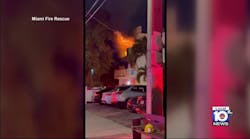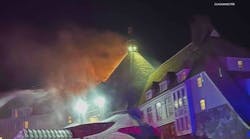Chief Charles Morgan
Personnel: 294 career firefighters
Apparatus: 10 pumpers, four aerials, one snorkel, one quint, five medic units, two attack units, one power unit, one tanker, one hazmat unit
Population: 191,000
Area: 79 square miles
Christmas is a time of thanks, peace, family togetherness and hope. For Captain Jim Hartzer, a 33-year veteran of the Des Moines, IA, Fire Department, Christmas Day 1995 was definitely a day of thanks for having been spared his life.
On the afternoon of Dec. 25, Hartzer and his crew from Pumper 4 responded to a house fire at 1120 21st St. in Des Moines. The structure was an older home which had undergone considerable remodeling. There had been at least two additions to the structure and it had been converted into a 10-unit apartment building.
The fire began when a candle ignited an over-dry Christmas tree, which witnesses said went up in flames in seconds. Residents of the apartment tried to combat the fire by throwing water on it for several minutes before calling the fire department. In that time, the fire only worsened. Within two hours, all 30 of the apartment building's residents would be homeless, and Hartzer would be in a hospital bed after being trapped for nearly an hour.
When Pumper 4 was dispatched, Hartzer the initial incident commander knew the crew was going to a working fire. Station 4 is located nearly a mile from the fire's location, and when Pumper 4 rolled out of the station, smoke could already be seen billowing into the sky.
On arrival, Hartzer's initial assessment found fire belching from windows on both the first and second floors of the 2 1/2-story frame building on both the north and west sides to its rear. With just his single crew on scene and with the extent of the fire, Hartzer knew an interior attack was out of the question. Had the fire been facing him, he would have squelched the flames with a deck gun attack, but instead he resorted to an attack with two 1 3/4-inch handlines from the exterior. This attack only slowed the fire.
On an initial alarm to a structural fire, the Des Moines Fire Department dispatches two engines, an aerial, a squad and a district chief. This provides a complement of a dozen firefighters. As additional apparatus and personnel arrived on scene, more hoselines and hose crews were put into operation and command was passed to the acting district chief, Captain William Burke.
The blaze was stubborn; it used the made-over construction to its advantage and firefighting efforts could not, after more than an hour, bring it completely under control. The "chopped-up" construction from so much remodeling made getting to the fire, which had spread extensively in the balloon construction, difficult in fact, nearly impossible. Even blasts from the hose streams of two aerial trucks could not completely subdue the fire. Burke and Hartzer had a conference and a line was drawn in the sand firefighters would make a stand and save the front half of the structure, which was undamaged by the fire. As firefighters worked toward this objective, Hartzer directed a hose crew at the back of the structure.
In his 33 years on the Des Moines Fire Department, Hartzer has seen a lot of building fires and has been an ardent student of fire behavior and building construction. He's been bruised and burned, had strains and sprains, had things fall on him, and he has seen many unfortunate circumstances, but nothing like what was about to happen.
Hartzer is a fire officer who would not intentionally endanger himself or another firefighter. Fellow firefighters acknowledge him as one of the best on the department and an officer whose wisdom and firefighting savvy were never in doubt.
"When he told you to do something, you knew it was safe to do," said one firefighter. "I never had any fear following Jimmy into a fire."
At about 5 P.M., as families throughout the city enjoyed holiday festivities, Hartzer stepped about 10 feet inside of a rear doorway of the burning structure in order to extinguish a few spot fires that were snaking up the wall and across the ceiling of the room. Behind him, bracing him against the force of the 1 3/4-inch handline, with his hand on Hartzer's shoulder, was Firefighter Ahman Douglass. In the doorway, managing the hoseline, was Firefighter Kevin Patton. Both Patton and Douglass are six-year veterans of the department. No one was wearing self-contained breathing apparatus (SCBA), as this continued to be an exterior attack and the room the firefighters entered was well ventilated and clear.
Hartzer quickly extinguished the fire, then turned to move his crew back outside. All he heard was a loud crack. Douglass noted there was "just a split second and you could tell something had shifted in the building."
In that fraction of a second, Douglass was hurled against Patton and both of them were pushed out of the doorway to the outside of the building. Smoke and bits of debris blasted from the doorway and for a few moments obscured their view of everything in front of them. As they regained their composure, they realized there had been a collapse and Hartzer was no longer with them.
The firefighters began pulling at the hoseline Hartzer had held in his hand. When the line came out of the rubble, all that the firefighters found at the end was a nozzle. At that point, they realized something was seriously wrong and they began pawing at the debris and yelling for Hartzer as well as for more help.
Everything that had been above Hartzer had come down on top of him and he was now in the basement, pinned under tons of debris he later said it felt like having "the weight of the world" on top of him.
At the time of the collapse, the structure had shown no signs of collapse; there was no sagging or bowing of any kind to indicate that this was about to happen. It was a combination of structural renovation, overloading of the upstairs floor (unknown to Hartzer, the room above him, which was originally designed as a bedroom, had been converted into a kitchen), the amount of fire damage and possibly termite damage that had all contributed to the collapse. At the time, the Building and Code Enforcement Department had several outstanding violations cited against the structure, none of which had been corrected.
Much had happened on the fire scene all at once. Part of the building had collapsed, a firefighter was trapped and there was still a raging fire going on. Burke, the incident commander, recalled that he felt sick to his stomach when word reached him that Hartzer was trapped, but it was no deterrent as Des Moines Fire Chief Charles Morgan later stated, "When I arrived on scene, everything was under control and everything was progressing in an orderly fashion."
Douglass and Patton continued trying to reach Hartzer as they desperately tried to recruit help. The firefighters stated in a report, "You felt so helpless. There was this huge pile of debris and Jim was in there somewhere. We didn't know if he was dead or alive."
When the collapse occurred, first the floor above Hartzer gave way to the side opposite the doorway he had entered. It swung downward, pushing Douglass out, then totally let go and came down. The walls and roof of the structure remained intact and on fire around the collapsed heap inside.
Time seemed to stand still as the events of the next hour unfolded. Onlookers went to notify other firefighters and the incident commander of what had just happened. Some of them grabbed and manned the hoseline while Douglass and Patton continued to try and find Hartzer.
"Firefighter trapped!" soon reverberated through radio traffic. Morgan, who was just sitting down for Christmas dinner at his son's (a Des Moines police officer) house, heard the message and both he and his son both immediately left for the scene.
Hartzer was under tons of debris that included a refrigerator and stove. Everything above him was pancaked down onto him. He was pinned in a fetal position, in a small void space, with one arm outstretched. He could not move his head or his body, only the fingers of his outstretched hand. A frantic, but organized effort quickly ensued to locate Hartzer as the firefighting strategy quickly changed from fire control to firefighter rescue. Chain saws, airbags nearly all of the pieces of special rescue equipment the Des Moines Fire Department had were used in the effort. Additional alarms were struck and eventually 15 firefighters were coordinated in the rescue effort, while the remainder worked to keep the fire in check.
The only way to reach Hartzer was by burrowing through the debris from above rather than tunneling in from the side. Not knowing exactly where he was under the debris and with the threat of collapsing more debris down onto him, the rescue effort was particularly tenuous. Firefighters had to be careful how far they cut and where they cut with chain saws, and much of the shoring up of unstable portions of the structure and debris pile had to be done with ropes, jacks, boards and whatever else was available.
The number of firefighters working in the area above Hartzer was monitored carefully because any additional weight could trigger more collapse. The firefighters working the rescue were operating under extreme difficulty as smoke, heat, steam and dripping tar from fires around them inundated the area.
As they progressed through the debris, firefighters could occasionally hear what sounded like a muffled voice when all of the noise of chain saws and rescue equipment was quieted. Finally, after nearly 30 minutes, the sounds could be distinguished as Hartzer's pleas for help. The morale of the rescuers was boosted, as they now knew he was still alive. Then, some debris was cleared, which exposed the fingers of his outstretched hand. He wiggled the fingers from beneath the floor joist that had him pinned, to let rescuers know where he was.
As rescuers got closer to him, Hartzer's condition worsened and the cold began to take its toll. His pleas for help began fading and the rescue effort took on a fevered pitch. Hartzer is unsure whether he was conscious throughout the entire ordeal. What he does remember is the great pain he was experiencing.
"It felt as if two horses were pulling my legs in opposite directions," he said. And, he remembers praying. "I prayed to God to get me through this; to give me the strength I needed and to help those who were trying to save me." Then, he began to think about things. "I thought about my wife and my family. Would I get to see them again? I had thought about retiring from the department. Now, would I get to retire?"
If Hartzer was anxious, so were his rescuers. Finally, after nearly an hour, he was freed. Paramedics were right there; he was strapped to a backboard and rushed to a hospital. A massive surge of relief welled up in everyone who was involved in the incident; "Merry Christmas!" was the statement of one of his fellow firefighters. Burke said he felt as if an immense load had been taken off of him.
Overshadowing their relief, however, was everyone's knowledge that one of their own had been seriously injured. Picking up and getting back in service after the fire was finally out was devoid of the usual spirited feeling firefighters have after having fought a challenging fire. "It was very somber; there was no laughter and no joking around," Douglass said.
No one's relief, though, was greater than that of Jim Hartzer, who literally felt as if the weight of the world had been lifted from him. His protective clothing had saved him in one sense, in that if he had not had a helmet on, or if it had been knocked off, his head would have been crushed. His turnout gear spared his body from more abrasion. Burke, however, noted that if Hartzer had been wearing SCBA, he might have suffocated, as he could not move his head and could not have gotten a hand to his mask to take it off if necessary.
Said Hartzer of his rescuers when he spoke of their professionalism and care: "In the firehouse you live together, eat together and work together. Sometimes you don't agree and sometimes you don't get along too well. But when something like this happens, all of that goes out the window and your fellow firefighters prove that they are your brothers. There was nothing I did that saved me. It was my brother firefighters and God that saved me."
Jokingly, one of his rescuers would later say to Hartzer in the best of firehouse humor, "if you hadn't been an officer, we would of had you out of there in 20 minutes instead of an hour."
If it was incredible that Hartzer was not killed, it was even more incredible that he was not injured more seriously than he was. He suffered no broken bones, but the muscles and tendons in his left leg and shoulder were crushed. His body temperature had dropped to 92 degrees in the cold. For more than two months following the incident, Hartzer underwent physical therapy for his injuries. In addition, he was plagued by nightmares and flashbacks that required the help of a stress psychologist.
In all, the incident went to six alarms, with 13 rigs including six engines, two aerials, three paramedic units, one power unit and one district chief responding along with 42 firefighters. For Hartzer it was of even more significance it was his last alarm.
"I'm retiring for sure now," he said. "I had been thinking about it, but I guess this is just someone's way of telling me it's time to quit. The fire service is a good career. I'm proud to have served as a firefighter."
In looking back on his career, Hartzer had one bit of wisdom for all firefighters: "Firefighting is a job where Murphy's law will prevail. You can train and have all of the experience and knowledge in the world, but the unexpected can always happen."
Steve Meyer has been a member of the Garrison, IA, Volunteer Fire Department for 15 years, serving as chief since 1985. He is president of the Iowa Fire Chiefs Association. Meyer is employed as a fire science and industrial fire brigade instructor at Kirkwood Community College and as a member of the field staff for the Iowa Fire Service Institute. He holds a bachelor of science degree in fire administration from the University of Cincinnati and is a graduate of the National Fire Academy Executive Fire Officer Program.






